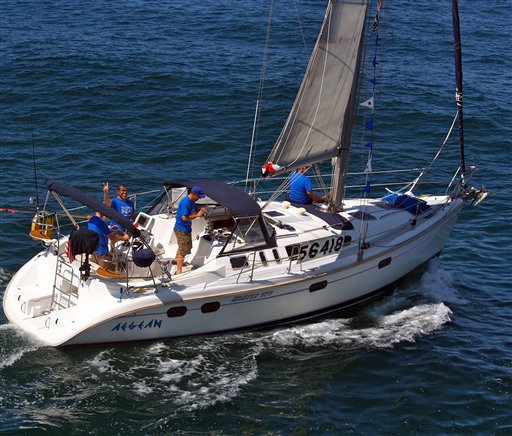SAN DIEGO — Since the first half of the 20th century, sailors seeking wind, waves and heady competition in California could race from Newport Beach to Ensenada, Mexico or sail out past the limits of the San Francisco Bay in the Full Crew Farallones Race.
Beer and exhilaration awaited them at the end, and they gave little thought to death and danger. At least until this spring.
Two weeks after five sailors were killed in the waters off Northern California when their 38-foot yacht was hit by powerful waves and ran aground on a rocky island, the sailing community was stunned again.
Three sailors were killed and one went missing, their yacht found in pieces near the Mexican border, perhaps in a collision with a large ship in the middle of the night.
The San Diego County medical examiner said Monday that Kevin Eric Rudolph, 53, of Manhattan Beach, died of blunt force injuries to his head and neck; William Reed Johnson Jr., 57, of Torrance, Calif., died of multiple blunt force injuries; and Joseph Lester Stewart, 64, of Bradenton, Fla., drowned. The boat’s skipper was missing.
The coroner’s report listed all three deaths as accidents but did not say what could have caused the wreck.
The Coast Guard was seeking records of any large ships in the area when the 37-foot Aegean was believed to have been destroyed early Saturday, said Lt. Bill Burwell, an agency spokesman.
Investigators are also examining the yacht’s debris and GPS coordinates and trying to find other race participants who were in the area.
Burwell, a Coast Guard pilot who helped locate the three bodies, said he isn’t ruling out that the yacht collided with rocks on Mexico’s Coronado Islands. Race organizers say they see no other explanation other than a collision with a larger ship.
“I think equal opportunity should be given to the idea that there wasn’t another vessel involved. The evidence doesn’t point to that yet, but the evidence doesn’t point anywhere,” he said.
Eric Lamb, who stumbled on the wreckage Saturday morning while on safety patrol, said debris strewn over 2 square miles looked as if the boat had “gone through a blender” — too small to suggest a collision with rocks.
By ocean racing standards, the number of casualties in the two races is startling. Previous major ocean racing disasters have been caused by freak storms, including the one that killed 15 sailors in the Irish Sea in the 1979 Fastnet Race and one that killed six in the 1998 Sydney to Hobart Race.
Gary Jobson, president of the U.S. Sailing Association, said he was “horrified” by the latest accident. “We need to take a step back and take a deep breath with what we’re doing. Something is going wrong here,” he said.
Jobson said he’s scheduled to speak by phone with a Coast Guard official in San Francisco today about a possible independent review panel, then hopes to do the same in San Diego.
Dennis Conner, a four-time winner of the America’s Cup who has also won the Newport to Ensenada Race, called the two accidents a “tragic coincidence.”
Conner didn’t participate in this year’s Newport to Ensenada Race.
“That race has been going on, sometimes with 500 boats, although there were more like 200 this year, and there’s never been a problem in 65 years. Hopefully it doesn’t disrupt the continuity of the race,” Conner said.
Other sailors who have participated in the races were stunned at what happened to the Aegean. While reluctant to assess blame, they found it hard to believe the sailors weren’t aware of the danger they were in.
Troy Sears, who owns the Next Level Sailing charter company in San Diego, wondered if fatigue was a factor. The wind was light, swells were modest and a small moon lit the sky. “The world is a much different place on the ocean at night,” he said.
Sears said he has a sophisticated tracking system and requires two people on watch while sailing at night.
“When I see a ship, I always assume that I have to get out of its way. I never let a ship get within miles of me,” he said.
Rudolph’s wife, Leslie, said he leaves two grown children and the couple would have celebrated their 27th anniversary May 26.
Leslie Rudolph said her husband was competing in the race for the third time with the Aegean’s skipper, Theo Mavromatis of Redondo Beach.
Mavromatis was a sailor his entire life and did not appear to have ever faced scrutiny about safety, said Conrad Thieme of Marina Sailing, which rented the yacht on his behalf. He previously won the race in his category.
“Based on his sailing resume, this whole occurrence is really surprising,” Thieme said.
The deaths are the first fatalities in the race’s 65 years.
They came two weeks after five sailors died in the waters off Northern California when their 38-foot yacht was hit by powerful waves, smashed into rocks and capsized during a race.
The accident prompted the Coast Guard’s temporary suspension of races outside San Francisco Bay. The Guard said the suspension will allow it and the offshore racing community to study to determine whether changes in races are needed to improve safety.
Send questions/comments to the editors.



Success. Please wait for the page to reload. If the page does not reload within 5 seconds, please refresh the page.
Enter your email and password to access comments.
Hi, to comment on stories you must . This profile is in addition to your subscription and website login.
Already have a commenting profile? .
Invalid username/password.
Please check your email to confirm and complete your registration.
Only subscribers are eligible to post comments. Please subscribe or login first for digital access. Here’s why.
Use the form below to reset your password. When you've submitted your account email, we will send an email with a reset code.